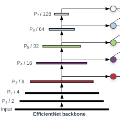Marine debris is a problem both for the health of marine environments and for the human health since tiny pieces of plastic called "microplastics" resulting from the debris decomposition over the time are entering the food chain at any levels. For marine debris detection and removal, autonomous underwater vehicles (AUVs) are a potential solution. In this letter, we focus on the efficiency of AUV vision for real-time and low-light object detection. First, we improved the efficiency of a class of state-of-the-art object detectors, namely EfficientDets, by 1.5% AP on D0, 2.6% AP on D1, 1.2% AP on D2 and 1.3% AP on D3 without increasing the GPU latency. Subsequently, we created and made publicly available a dataset for the detection of in-water plastic bags and bottles and trained our improved EfficientDets on this and another dataset for marine debris detection. Finally, we investigated how the detector performance is affected by low-light conditions and compared two low-light underwater image enhancement strategies both in terms of accuracy and latency. Source code and dataset are publicly available.
翻译:海洋废弃物对海洋环境健康和人类健康都是一个问题,因为随着时间的推移,碎片分解产生的微塑料小块“微塑料”正在进入食物链的各个层次。对于海洋废弃物的探测和清除,自主水下车辆(AUV)是一个潜在的解决办法。在本信中,我们侧重于AUV实时和低光天体探测愿景的效率。首先,我们提高了一类最先进的物体探测器的效率,即高效天体探测器的效率,在D0上提高了1.5%的AP,在D1上提高了2.6%的AP,在D1上提高了2.6%的AP,在D2上提高了1.2%的AP,在D3上提高了1.3%的AP,而没有增加GPU Lantency。随后,我们创建并公开提供了一套用于探测水中塑料袋和瓶子的数据集,并培训了我们改进后的高效数据,以及用于海洋废弃物探测的另外一套数据集。最后,我们研究了探测器的性能如何受到低光度条件的影响,并比较了两种低光水下图像增强战略,在精确度和衬底码和数据集方面都公开提供。



